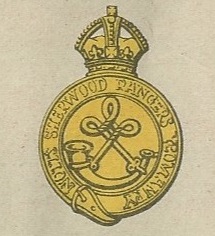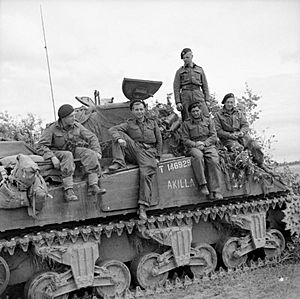Sherwood Rangers Yeomanry facts for kids
Quick facts for kids Sherwood Rangers Yeomanry |
|
|---|---|
 |
|
| Active | 1794–present |
| Country | |
| Branch | |
| Type | Yeomanry |
| Size | First World War Three regiments Second World War One regiment |
| Part of | Territorial Force Royal Armoured Corps |
| Garrison/HQ | Nottingham |
| Motto(s) | Loyal unto Death |
| Colours | Green and Gold |
| March | The Sherwood Rangers |
| Engagements | Second Boer War First World War
|
| Battle honours | See battle honours below |
| Commanders | |
| Honorary Colonel | Major Andrew M. Smith, TD, JP |
| Notable commanders |
Lt Col Vernon Willey, 2nd Baron Barnby Lt Col Sir Albert Bennett, 1st Bt. Col E. O. Kellett DSO MP Lt Col S. D. Christopherson DSO MC US Silver Star Lt Col Sir Thomas White, 1st Bt. Lt Col Sir Thomas White, 2nd Bt. |
The Sherwood Rangers Yeomanry (SRY) was a special British army group. It was made up of volunteers, not full-time soldiers. In 1967, it joined with other groups to form the Royal Yeomanry. This new group is a light cavalry regiment, which means they are soldiers who move quickly. They are part of the Army Reserve, which is like a backup army.
The Sherwood Rangers started in 1794 as the Nottinghamshire Yeomanry Cavalry. For many years, they helped keep peace and order in Britain. They fought in the Second Boer War and both World Wars. They earned 44 special awards called "battle honours" for their bravery. Today, they are known as 'A' Squadron of the Royal Yeomanry. Their job is to find out what the enemy is doing for other army groups.
History of the Sherwood Rangers
How the Rangers Started
The Sherwood Rangers Yeomanry began in the summer of 1794. It was started by a man named Thomas White. He paid for the group himself and even let them stay at his home. King George III gave Sir Thomas a special title, a "baronetcy," because he was so loyal. The Rangers took Sir Thomas's family motto, "Loyal Unto Death," as their own.
Fighting in the Second Boer War
The Yeomanry groups were not usually sent to fight in other countries. But in December 1899, the British army faced some tough losses in the Second Boer War. The government realized they needed more soldiers. So, they asked volunteer groups like the Yeomanry to help.
The Sherwood Rangers sent about 115 men to South Africa. These men were called "mounted infantry." This meant they rode horses but fought on foot. This idea worked well. After the war, the group was called the Nottinghamshire Imperial Yeomanry (Sherwood Rangers). By 1914, their main base was in Retford.
The First World War
When the First World War started in 1914, the Yeomanry was meant to defend Britain. But many members wanted to fight overseas. So, the groups were split into three parts:
- 1st Line: These soldiers went to fight in other countries.
- 2nd Line: These soldiers stayed in Britain for defense.
- 3rd Line: This group trained new soldiers to replace those fighting.
1st Sherwood Rangers Yeomanry in WWI
The 1st Sherwood Rangers fought in Egypt as cavalry, riding horses. In 1915, they were sent to Gallipoli. There, they fought on foot like regular infantry soldiers for three months. They were so brave that they received a special flag called the "King's Colour."
After Gallipoli, they went back to Egypt as cavalry. They then fought in North Greece and Palestine. They were part of a big cavalry charge from Gaza to Aleppo.
2nd Sherwood Rangers Yeomanry in WWI
The 2nd Sherwood Rangers group was formed in 1915. They stayed in Britain for defense. At first, they were mounted soldiers. But in 1917, they changed to "cyclists," meaning they rode bicycles. They stayed near Canterbury until the war ended.
3rd Sherwood Rangers Yeomanry in WWI
The 3rd Sherwood Rangers group was formed in 1915. Their job was to train new soldiers. They sent trained replacements to the 1st and 2nd Line groups.
Between the World Wars
After the First World War, leaders decided that horses were not as important for fighting anymore. So, many Yeomanry groups changed their roles. The Sherwood Rangers were one of the few groups that stayed as horse cavalry at first. But later, they also started to change. Some groups became armored car companies or artillery units.
The Second World War
Before the Second World War, the Sherwood Rangers were still a cavalry unit. In 1939, when the war began, they moved to Palestine. In 1940, they changed to an artillery unit, using big guns. They helped defend places like Tobruk and Benghazi and fought in the battle of Crete.
In 1941, the Rangers became an armored unit. This meant they used tanks like the M3 Grant and M4 Sherman. They fought in many big battles in North Africa, including Alam El Halfa and Second El Alamein.
The Sherwood Rangers landed in France on D-Day in 1944. They used special "swimming" Sherman tanks. They fought hard in Normandy and helped push across France and Belgium. In September 1944, their scouting team was the first British unit to fight inside Germany. They continued fighting around the Rhine River and pushed all the way to Bremen by the end of the war.
After the Wars
In 1947, the Sherwood Rangers became an armored regiment again. In 1961, they changed to a reconnaissance unit, which means they focused on scouting and gathering information. In 1967, they became a squadron (a smaller group) of the new Royal Yeomanry.
Over the years, they used different armored vehicles like the Ferret, Alvis Saladin, and Fox Armoured Reconnaissance Vehicle. They also used command vehicles and armored ambulances. In 1992, they joined the Queen's Own Yeomanry for a while. They rejoined the Royal Yeomanry in 1999, working with Challenger 2 tanks. Today, they are a "light cavalry" unit, using Land Rover RWMIK vehicles for scouting.
Regimental Museum
You can learn more about the Sherwood Rangers Yeomanry at their museum. The Royal Lancers and Nottinghamshire Yeomanry Museum is located at Thoresby Hall in Nottinghamshire.
Battle Honours
Battle honours are special awards given to military units for their bravery in battles. The Sherwood Rangers Yeomanry earned many of these. The ones in bold are proudly displayed on their Regimental Guidon (a special flag).
| Second Boer War | South Africa 1900–02 |
| First World War | Struma, Macedonia 1916–17, Suvla, Scimitar Hill, Gallipoli 1915, Egypt 1915–16, Gaza, El Mughar, Nebi Samwil, Megiddo, Sharon, Damascus, Palestine 1917–18 |
| Second World War | Normandy Landing, Villers Bocage, Odon, Fontenay le Pesnil, Defence of Rauray, Mont Pincon, Noireau Crossing, Seine 1944, Gheel, Nederrijn, Geilenkirchen, Roer, Rhineland, Cleve, Goch, Weeze, Rhine, North-West Europe 1944–45, Alam el Halfa, El Alamein, El Agheila, Advance on Tripoli, Tebaga Gap, Point 201 (Roman Wall), El Hamma, Chebket en Nouiges, Enfidaville, Takrouna, North Africa 1940–43 |
Uniform
Before World War I, the Sherwood Rangers had a very special uniform. It included a "rich dark green" jacket and trousers. These were decorated with gold and yellow braids. The short jacket was a style that regular army groups had stopped using years before. Officers had a fancy gold belt. For parades, all soldiers wore tall, furry hats called "busbies" with white and green feathers. For less formal times, they wore a dark green jacket and green hats with yellow bands. After 1914, they wore standard khaki army uniforms with their special badges.
See also
- Imperial Yeomanry
- List of Yeomanry Regiments 1908
- Yeomanry
- Yeomanry order of precedence
- British yeomanry during the First World War
- Second line yeomanry regiments of the British Army


